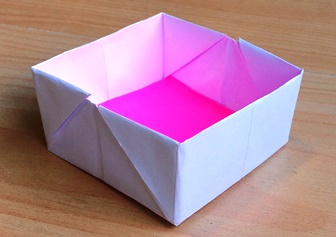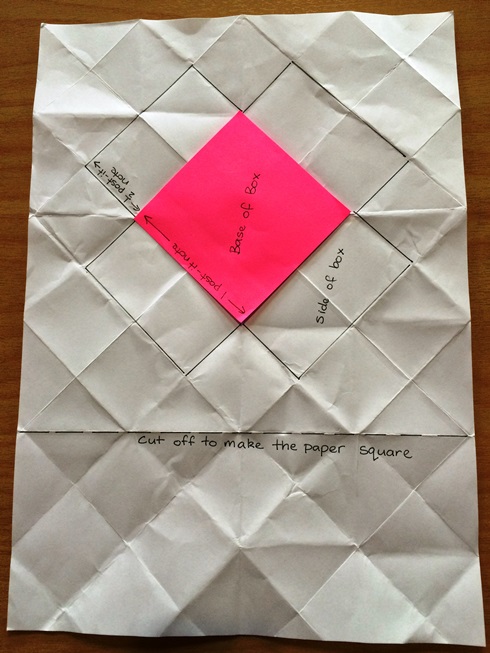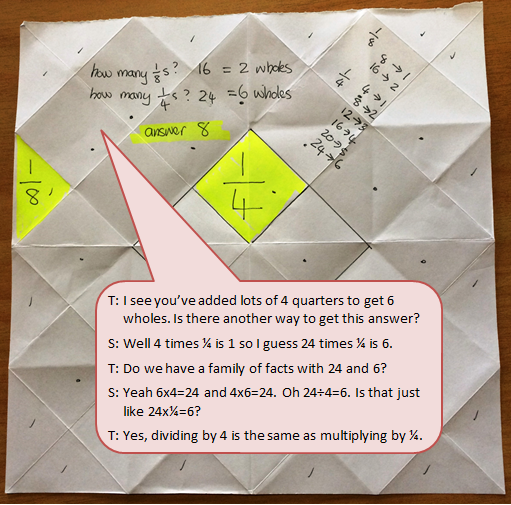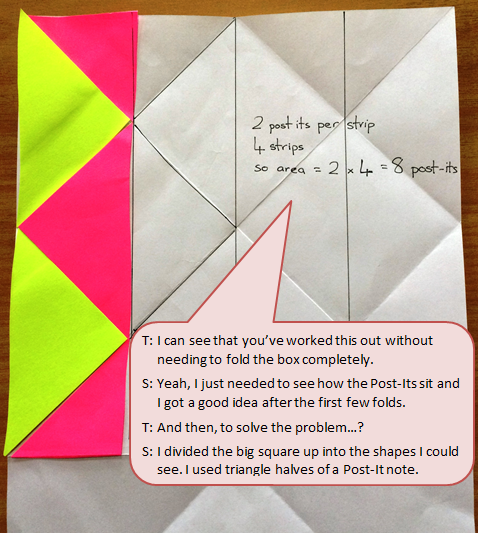The purpose of this activity is to engage students in using non-standard units to solve a problem involving area.
This activity assumes the students have experience in the following areas:
- Finding the areas of rectangles, including squares.
- Using standard metric units for length and area.
- Recognising area as the amount of flat space.
The problem is sufficiently open ended to allow the students freedom of choice in their approach. It may be scaffolded with guidance that leads to a solution, and/or the students might be given the opportunity to solve the problem independently.
The example responses at the end of the resource give an indication of the kind of response to expect from students who approach the problem in particular ways.
An origami box, folded from the biggest square that can be cut from a sheet of A4 paper, just fits a post-it note in its base.
The height of that box is half a post-it note. Use an unfolded origami box to work out how many post-it notes fit within the biggest square of a sheet of A4 paper.
The following prompts illustrate how this activity can be structured around the phases of the Mathematics Investigation Cycle.
Make sense
Introduce the problem. Allow students time to read it and discuss in pairs or small groups.
- Do I understand the situation and the words? (Student might benefit from watching a video of an origami box being folded.)
- Can I say the problem in my own words? (The goal is to work the number of post-it note that are equal to the area of the large square made from A4 paper.)
- What maths is involved in this problem? Can I describe area?
Plan approach
Discuss ideas about how to solve the problem. Emphasise that, in the planning phase, you want students to say how they would solve the problem, not to actually solve it.
- How might I use the pictures to solve the problem? What other strategies might I use?
- What shape will make a good unit of area? Why?
- What are the maths skills I need to work this out? How do I work out the areas of rectangles usually?
- What shapes are important in this problem? How will I use the shapes?
- What calculations will I need to do?
- How will I record my calculations?
- What tools (digital or physical) could help my investigation?
Take action
Allow students time to work through their strategy and find a solution to the problem.
- Is my strategy working? Should I try something else?
- Is my recording helping me to find an answer? Is my recording clear to others?
- Am I able to measure area with the shapes in the picture? Which shapes am I using to do that?
- How could I make sure that I haven’t missed anything?
- Are there any patterns with the shapes?
- How might I describe the patterns?
- Does the pattern help me to answer the question?
- Does my answer seem correct? Is it close to what I expected?
Convince yourself and others
Allow students time to check their answers and then either have them pair share with other groups or ask for volunteers to share their solution with the class.
- What is the solution?
- Is my working clear for someone else to follow?
- How would I convince someone else I am correct?
- Could I have solved the problem in a more efficient way? Is my strategy the most efficient way? What could I try differently next time?
- What connections can I see to other situations, why would this be? Have I used connecting shapes elsewhere?
- Which ideas or tools worked well in my investigation?
Examples of work
Work sample 1
The student recognises that each folded square is one quarter of a post-it note. They use multiplication to find the number of quarters in the large square and divides that number by four to get the total number of post-it notes.
Click on the image to enlarge it. Click again to close.
Work sample 2
The student divides the large square into strips and calculates the number of post-it notes in a strip, using the triangles as a unit of area. They multiply the answer by four to get the total number of post-it notes.



